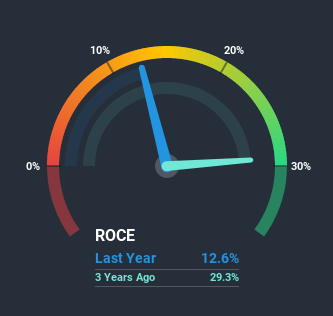We're Watching These Trends At Berkeley Group Holdings (LON:BKG)

Did you know there are some financial metrics that can provide clues of a potential multi-bagger? Typically, we'll want to notice a trend of growing return on capital employed (ROCE) and alongside that, an expanding base of capital employed. If you see this, it typically means it's a company with a great business model and plenty of profitable reinvestment opportunities. Having said that, from a first glance at Berkeley Group Holdings (LON:BKG) we aren't jumping out of our chairs at how returns are trending, but let's have a deeper look.
What is Return On Capital Employed (ROCE)?
Just to clarify if you're unsure, ROCE is a metric for evaluating how much pre-tax income (in percentage terms) a company earns on the capital invested in its business. Analysts use this formula to calculate it for Berkeley Group Holdings:
Return on Capital Employed = Earnings Before Interest and Tax (EBIT) ÷ (Total Assets - Current Liabilities)
0.13 = UK£470m ÷ (UK£5.7b - UK£1.9b) (Based on the trailing twelve months to April 2020).
Therefore, Berkeley Group Holdings has an ROCE of 13%. That's a relatively normal return on capital, and it's around the 12% generated by the Consumer Durables industry.
View our latest analysis for Berkeley Group Holdings
Above you can see how the current ROCE for Berkeley Group Holdings compares to its prior returns on capital, but there's only so much you can tell from the past. If you'd like, you can check out the forecasts from the analysts covering Berkeley Group Holdings here for free.
What Does the ROCE Trend For Berkeley Group Holdings Tell Us?
When we looked at the ROCE trend at Berkeley Group Holdings, we didn't gain much confidence. To be more specific, ROCE has fallen from 29% over the last five years. And considering revenue has dropped while employing more capital, we'd be cautious. If this were to continue, you might be looking at a company that is trying to reinvest for growth but is actually losing market share since sales haven't increased.
On a side note, Berkeley Group Holdings has done well to pay down its current liabilities to 34% of total assets. That could partly explain why the ROCE has dropped. Effectively this means their suppliers or short-term creditors are funding less of the business, which reduces some elements of risk. Some would claim this reduces the business' efficiency at generating ROCE since it is now funding more of the operations with its own money.
The Bottom Line
In summary, we're somewhat concerned by Berkeley Group Holdings' diminishing returns on increasing amounts of capital. Yet despite these concerning fundamentals, the stock has performed strongly with a 54% return over the last five years, so investors appear very optimistic. Regardless, we don't feel to comfortable with the fundamentals so we'd be steering clear of this stock for now.
If you'd like to know about the risks facing Berkeley Group Holdings, we've discovered 1 warning sign that you should be aware of.
While Berkeley Group Holdings may not currently earn the highest returns, we've compiled a list of companies that currently earn more than 25% return on equity. Check out this free list here.
This article by Simply Wall St is general in nature. It does not constitute a recommendation to buy or sell any stock, and does not take account of your objectives, or your financial situation. We aim to bring you long-term focused analysis driven by fundamental data. Note that our analysis may not factor in the latest price-sensitive company announcements or qualitative material. Simply Wall St has no position in any stocks mentioned.
Have feedback on this article? Concerned about the content? Get in touch with us directly. Alternatively, email editorial-team@simplywallst.com.

